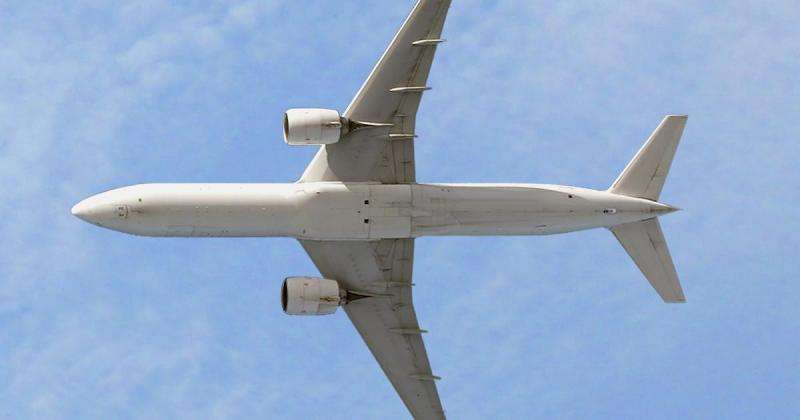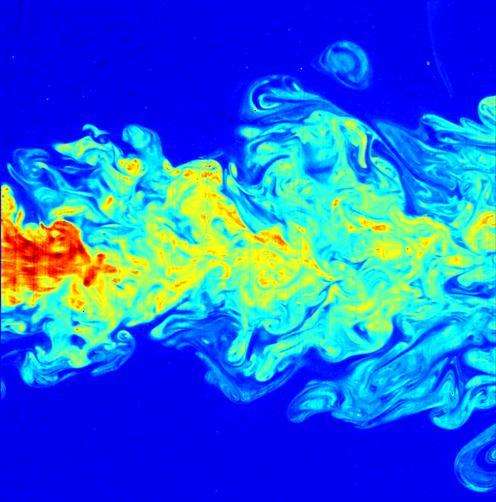Credit: University of Melbourne
You're sitting in an aeroplane, maybe reading a book or watching a movie, a tray of unopened food in front of you. Suddenly, the plane jolts and starts to bump up and down. You grab hold of the armrest, hastily tighten your seatbelt and say a silent prayer.
Does this scenario seem familiar? If you've flown you've probably experienced turbulence at some point. But despite how common it is, many people are terrified of it and are convinced a plane could be damaged or even crash.
Is this fear reasonable or are passengers needlessly stressing themselves out?
University of Melbourne Associate Professor Todd Lane, from the ARC Centre of Excellence for Climate System Science in the School of Earth Sciences, says this fear is understandable but mostly unwarranted.
"There is a perception that turbulence makes air travel unsafe and people are worried about their plane crashing," Associate Professor Lane says. "I think people are more scared than they should be because they hear in the news about these rare events of severe turbulence and people getting injured.
"Think about the number of flights to and from, and within Australia, every year: on average there's only about 40 people injured on those flights per year due to turbulence. That's a really small number when you compare it to the number of flights and the millions upon millions of people flying."
Turbulence occurs when there is a naturally occurring disturbance in the atmosphere and an aircraft flies through it. Like ocean waves, there are also waves in the atmosphere formed by airflow over mountains or phenomena like thunderstorms. And like in the water, these atmospheric waves can break, which in turn causes that airflow to be disrupted.
It's not unlike driving on a road that is a bit bumpy at times – it can be uncomfortable but most of the time, it isn't unsafe.
Lots of weather systems cause turbulence – strong cold fronts, jet streams and thunderstorms, especially in the tropics. Associate Professor Lane researches meteorology and atmospheric science, including atmospheric dynamics, thunderstorms, aircraft turbulence and cloud processes.
Storms are a common cause of turbulence. Credit: Pixabay
He says at aircraft altitudes, the air tends to flow horizontally, but instability in the atmosphere will cause the air to move vertically, causing turbulence.
"Patches of turbulence are normally pancake-shaped, especially in clear-air turbulence.
"This is actually quite important, because when an aircraft is flying along and experiencing turbulence, the most common way to avoid it is to change altitude," he says.
Pilots can change altitude by just a few hundred feet either up or down in order to avoid turbulence, and fly in more stable atmosphere.
But even during quite bumpy turbulence, commercial planes are rarely jolted more than about 20 feet – far less than the 'diving in mid-air' that some people describe turbulence as feeling.
Commercial aircrafts are designed to withstand an incredible amount of stress and force – two and a half times that which they are likely to encounter.
There are four types of turbulence – light, moderate, severe and extreme. Light turbulence is extremely common, while moderate turbulence, which can cause rapid jumps or jolts, is quite rare: between one and five per cent of all turbulence experienced. Severe turbulence, which is when a person risks injury and the aircraft is thrown around violently – is even rarer. In fact, Associate Professor Lane says it occurs in only about 0.0001 per cent of flights worldwide.
Extreme turbulence is even rarer, again. There is only one recorded plane crash that is associated with turbulence. In 1966, A BOAC flight leaving Tokyo Airport crashed into Mount Fuji about 25 minutes after take-off after it flew into extreme turbulence. However, there is also speculation that the pilot flew too close to the mountain in order to provide passengers with a better view.
A frequent flyer because of his work, Associate Professor Lane is one of the few people who has experienced severe turbulence
A visualization of turbulent air, made by laser-induced fluorescence. Credit: Wikipedia
"We were flying over the Rocky Mountains in the US, and there had just been the drinks service. Suddenly, I felt myself lift out of my seat, but thankfully I was restrained by my seatbelt.
"My drink hit the ceiling, as did everybody's drink. It was a really short-lived event – it lasted about 10 seconds – and then things went back to normal. It was one of those encounters that scared everyone, people screamed a bit and then we wiped the drinks off ourselves."
Despite this incident, Associate Professor Lane says it hasn't put him off flying at all.
"Injuries caused by turbulence are very rare, and when it does happen, it's normally because people weren't wearing their seatbelts or they were walking around the cabin," he says. "Things like this create this perception that flying is unsafe but it is very safe. It's more dangerous driving your car the airport than actually flying."
He says if you're a nervous flyer, it's best to keep your seatbelt on at all times and try to avoid sitting near the back of the plane.
"Different parts of the plane feel turbulence more than others. The back of the plane usually feels bumpier than anywhere else in the plane, because it's further away from the centre of mass of the aircraft.
"So if you're closer to the front or near the wings, then you usually feel less turbulence."
What can you do to avoid injuries during turbulence?
- Keep your seatbelt on at all times
- Make sure all your luggage and bags are stowed safely
- Ensure you pay attention to instructions and requests from cabin staff
- Stay calm
Provided by University of Melbourne
























